Its a nice feeling when you know that someone likes you,
someone thinks about you,someone needs you;but it feels much better when you know that someone never ever forgets your birthday.
“HAPPY BIRTHDAY”.Sir..................
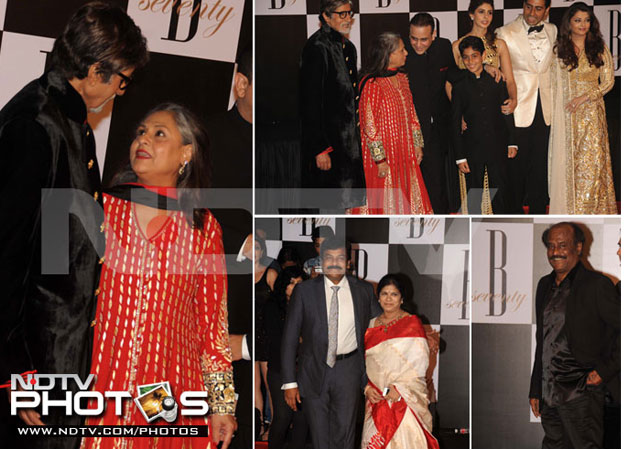
Amitabh Bachchan, dressed in a black velvet outfit, came with his family -- wife Jaya Bachchan, son Abhishek, daughter Shweta, daughter-in-law Aishwarya Rai Bachchan
The red carpet at Amitabh Bachchan's 70th birthday party was not just a roster of the who's who of Indian cinema, it was also a walk down memory lane. Rubbing shoulders with today's stars were a roll call of Mr Bachchan's co-stars from his glory days as the Angry Young Man.
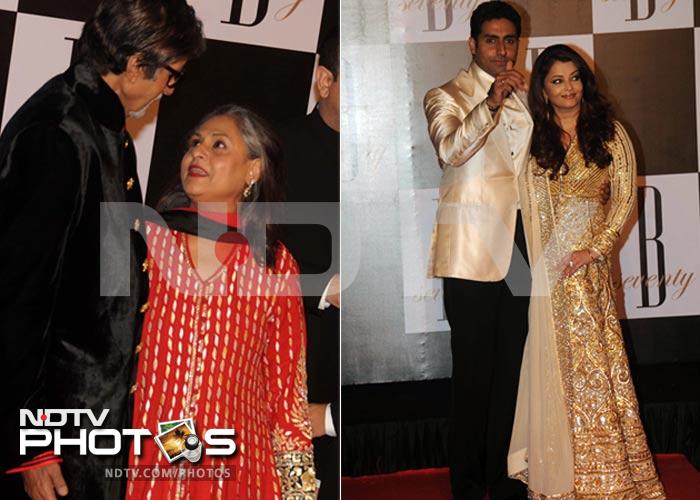
Perfect picture: Big B, Jaya, Abhishek and AishwaryaThe Indian film industry's biggest stars like Dilip Kumar, Yash Chopra, Shah Rukh Khan and southern superstar Rajinikanth to high profile politicians like Samajwadi supremos Mulayam and Akhilesh Singh Yadav, and Union Minister Praful Patel flocked to the big bash organised on Wednesday to usher in Amitabh Bachchan's 70th birthday.The red carpet was rolled out for as many as 800 guests at the Reliance Media Work, Film City, Goregaon.
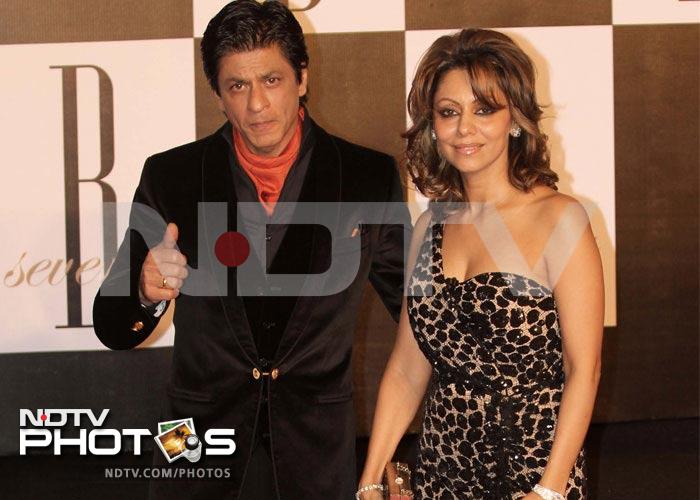
SRK with wife GauriMr Bachchan, dressed in a black velvet outfit, came with his family -- wife Jaya Bachchan, son Abhishek, daughter Shweta, daughter-in-law Aishwarya Rai Bachchan -- and he too walked the red carpet with a live orchestra playing hit numbers from his films.

Graceful Beauties - Sridevi and Madhuri Dixit with their husbands.Mr Bachchan, who turns 70 today, told the media, "Thanks for coming", while Aishwarya, lovely in gold, told reporters, "We are so happy that we are all here today celebrating his birthday. Thank you so much."Leading the Bollywood gang were old-timers and Big B collaborators Hema Malini (Satte Pe Satta, Naseeb), Waheeda Rehman (Kabhi Kabhie, Trishul), Vinod Khanna (Amar Akbar Anthony, Hera Pheri), Pran (Don, Zanjeer), Zeenat Aman (Don, Pukar), Danny Denzongpa (Agneepath, Hum), Neetu and Rishi Kapoor (The Great Gambler, Amar Akbar Anthony, Naseeb) and Shashi Kapoor, with whom Big B made a memorable Jodi in Deewar, Shaan and Namak Halall, who was wheeled in to join the revelries.From the South, superstars Rajinikanth, who co-starred with Amitabh Bachchan in Hum, Khuda Gawah co-star Nagarjuna and Chiranjeevi with family were early arrivals. Chiranjeevi's son Ram Charan Teja is making his Bollywood debut playing the role that made Amitabh Bachchan famous - inspector Vijay - in a remake of 1973 hit Zanjeer.Aishwarya and Abhishek played the perfect hosts and escorted 89-year old legend Dilip Kumar inside the venue.Mr Bachchan's one time competitor Vinod Khanna, who rarely speaks to the media, was in a generous mood and said: "I wish him all the happiness and good luck." From the current lot of young actors, stars like Deepika Padukone, Parineeti Chopra, Anurag Kashyap and his wife Kalki Koechlin, Sonakshi Sinha, Vidya Balan, John Abraham and Arshad Warsi came to wish Mr Bachchan.
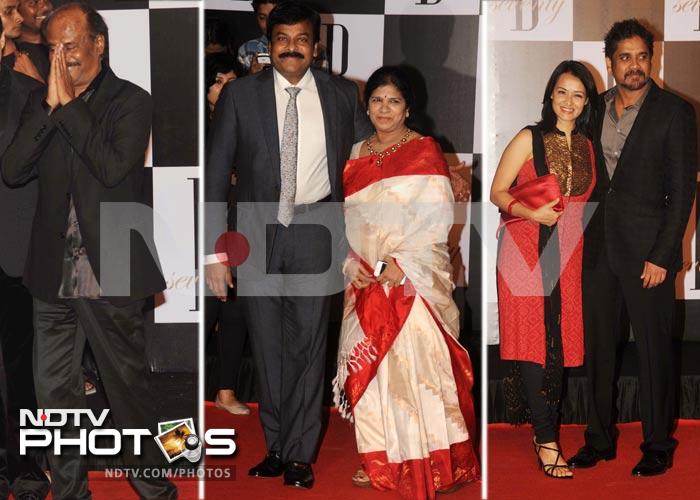
Southern spice: Rajinikanth, Chiranjeevi, NagarjunaOther guests included Khuda Gawah co-star Sridevi, Madhuri Dixit with her husband Sriram Nene, Shakti co-star Anil Kapoor, Ajay Devgn and Kajol, Mahima Chaudhary, Abbas Mastan, Sudhir Mishra, Subhash Ghai, Alka Yagnik, Boman Irani, R Madhavan, Ameesha Patel, Tabu, Sanjay Dutt, Sunil Shetty, Jackie Shroff, Divya Dutta, Ashutosh Gowariker, Juhi Chawla, Preity Zinta, Vipul Shah, Rana Daggubati and Urmila Matondkar.Main Azad Hoon co-star Shabana Azmi called him an "iconic figure" and added: "I got an opportunity to work with him. He is my favourite."Madhuri wished him all the "happiness and success", while Juhi said: "I respect him, admire him and I had a great time working with him."Vidya, who played his mother in Paa, said that "he is an inspiration not only for actors but for everyone".If glamour was at its peak, the big names from the political corridor including Nationalist Congress Party (NCP) leader Praful Patel, Shiv Sena executive president Uddhav Thackeray, Samajwadi Party supremo Mulayam Singh Yadav and his son and Uttar Pradesh Chief Minister Akhilesh Yadav also gathered here to wish Mr Bachchan.
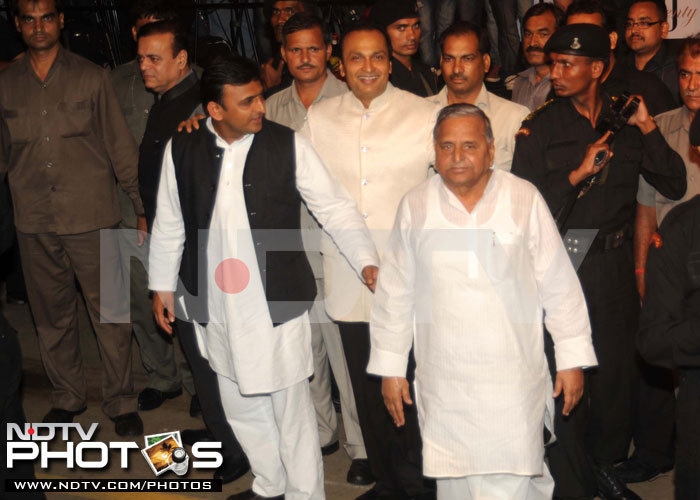
Samajwadi Party supremo with his son and Uttar Pradesh Chief Minister Akhilesh Yadav and Anil Dhirubhai Ambani Group's chairman Anil Ambani.Not to be left behind was businessman Anil Ambani, an old friend of Amitabh Bachchan.Watch video
































